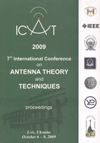UWB planar antenna dipole in the sandwich configuration
DOI:
https://doi.org/10.1109/ICATT.2009.4435148Keywords:
UWB, dipole antenna, planar antennaAbstract
In this article, we focus on the problem of reduction of UWB planar radiators dimensions. In order to minimize the dipole radiator, a sandwich structure has been designed – the radiator arms between two dielectric substrates.
A circular radiator has been chosen for purpose of our analysis and experimental verification. The optimal value of the radius has been chosen for the sandwich configuration, so that the minimal value of VSWR can be achieved. We introduced also an appriopriate balun designed for the proposed radiator and then we manufactured complete antenna. Due to an implementation of the sandwich configuration a width of the circular radiator arms get smaller for about 20% in comparison with circular radiator manufactured on a single dielectric substrate without significant differences of electric parameters. Additionally the input impedance of the radiator is smaller in comparison with onesubstrate structure, so the matching procedure is easier. VSWR of the antenna is less than -11 dB in the whole UWB band and the radiation patterns are similar to those of the antenna on a single substrate.
References
WIESBECK, W.; ADAMIUK, G. Antennas for UWB Systems. Proc. of 2nd Int. ITG Conf. on Antennas, INICA’07, 28-30 Mar. 2007. 2007, p.67-71.
PERGOŁ, M.; ZIENIUTYCZ, W. A New Planar Dipole for UWB Application. Proc. of XVII Int. Conf. on Microwaves, Radar and Wireless Communications, MIKON, Wrocław, 2008, v.1, p.109-112.
SUH, YOUNG_HO; CHANG, KAI. A Wideband Coplanar Stripline to Microstrip Transition. IEEE Microwave and Wireless Components Lett., 2001, v.11, p.28-29.

